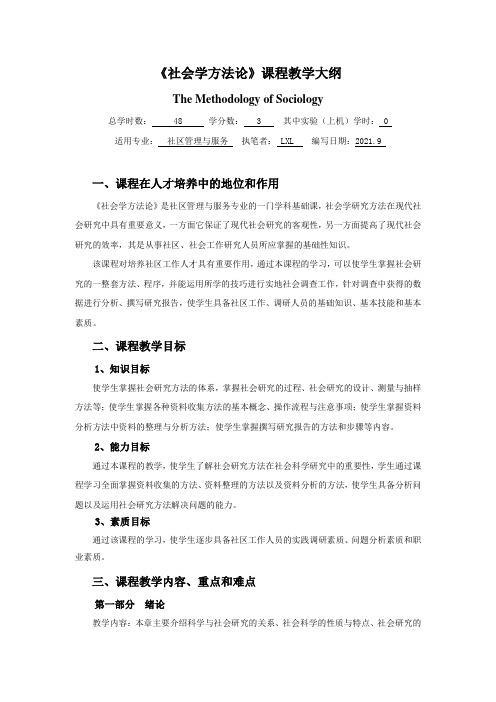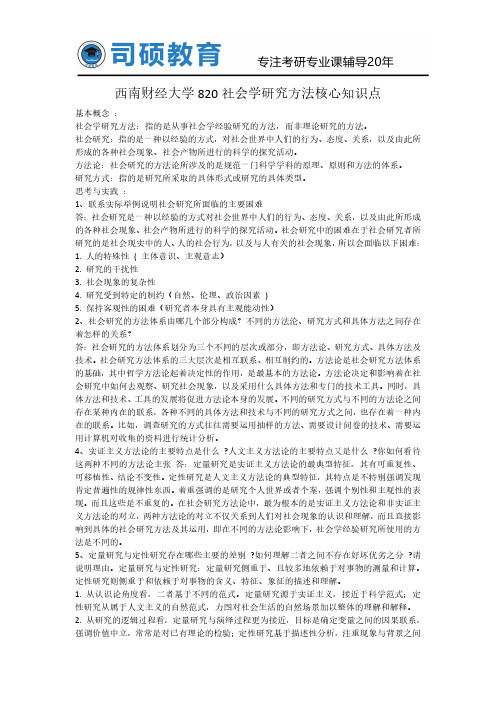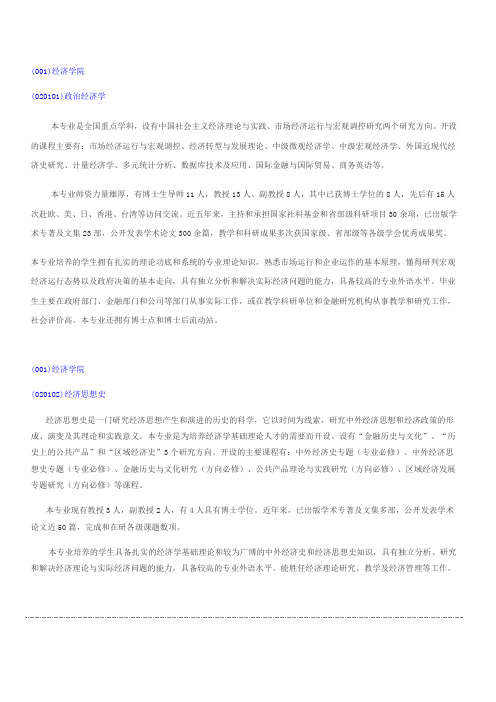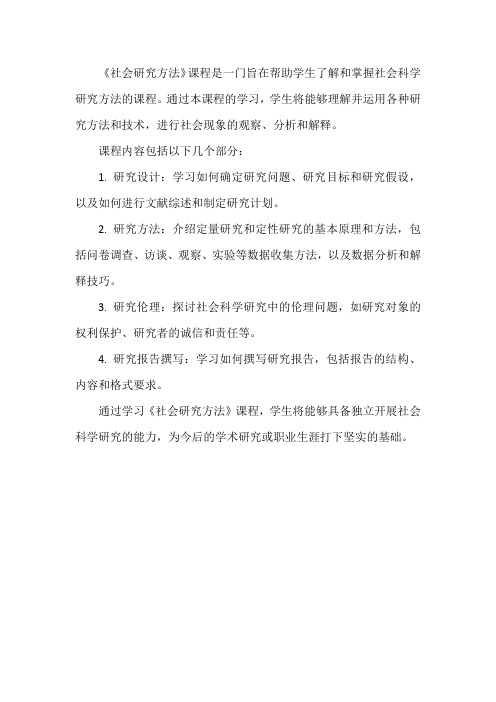西南财大——社会研究方法课程简介
社会研究方法教学大纲

《社会学方法论》课程教学大纲The Methodology of Sociology总学时数: 48 学分数: 3 其中实验(上机)学时: 0适用专业:社区管理与服务执笔者: LXL 编写日期:2021.9一、课程在人才培养中的地位和作用《社会学方法论》是社区管理与服务专业的一门学科基础课,社会学研究方法在现代社会研究中具有重要意义,一方面它保证了现代社会研究的客观性,另一方面提高了现代社会研究的效率,其是从事社区、社会工作研究人员所应掌握的基础性知识。
该课程对培养社区工作人才具有重要作用,通过本课程的学习,可以使学生掌握社会研究的一整套方法、程序,并能运用所学的技巧进行实地社会调查工作,针对调查中获得的数据进行分析、撰写研究报告,使学生具备社区工作、调研人员的基础知识、基本技能和基本素质。
二、课程教学目标1、知识目标使学生掌握社会研究方法的体系,掌握社会研究的过程、社会研究的设计、测量与抽样方法等;使学生掌握各种资料收集方法的基本概念、操作流程与注意事项;使学生掌握资料分析方法中资料的整理与分析方法;使学生掌握撰写研究报告的方法和步骤等内容。
2、能力目标通过本课程的教学,使学生了解社会研究方法在社会科学研究中的重要性,学生通过课程学习全面掌握资料收集的方法、资料整理的方法以及资料分析的方法,使学生具备分析问题以及运用社会研究方法解决问题的能力。
3、素质目标通过该课程的学习,使学生逐步具备社区工作人员的实践调研素质、问题分析素质和职业素质。
三、课程教学内容、重点和难点第一部分绪论教学内容:本章主要介绍科学与社会研究的关系、社会科学的性质与特点、社会研究的概念及其方法等内容。
教学重点:社会科学的性质与特点、社会研究及其方法。
教学难点:社会研究与社会调查、社会学研究的区别、联系;社会研究方法体系。
第二部分社会研究发展史教学内容:本章主要介绍社会研究方法论的演进、社会研究手段的发展、社会调查研究的历史等内容。
西南财经大学820社会学研究方法核心知识点

西南财经大学820社会学研究方法核心知识点基本概念:社会学研究方法:指的是从事社会学经验研究的方法,而非理论研究的方法。
社会研究:指的是一种以经验的方式,对社会世界中人们的行为、态度、关系,以及由此所形成的各种社会现象、社会产物所进行的科学的探究活动。
方法论:社会研究的方法论所涉及的是规范一门科学学科的原理、原则和方法的体系。
研究方式:指的是研究所采取的具体形式或研究的具体类型。
思考与实践:1、联系实际举例说明社会研究所面临的主要困难答:社会研究是一种以经验的方式对社会世界中人们的行为、态度、关系,以及由此所形成的各种社会现象、社会产物所进行的科学的探究活动。
社会研究中的困难在于社会研究者所研究的是社会现实中的人、人的社会行为,以及与人有关的社会现象,所以会面临以下困难:1.人的特殊性(主体意识、主观意志)2.研究的干扰性3.社会现象的复杂性4.研究受到特定的制约(自然、伦理、政治因素)5.保持客观性的困难(研究者本身具有主观能动性)2、社会研究的方法体系由哪几个部分构成?不同的方法沦、研究方式和具体方法之间存在着怎样的关系?答:社会研究的方法体系划分为三个不同的层次或部分,即方法论、研究方式、具体方法及技术。
社会研究方法体系的三大层次是相互联系、相互制约的。
方法论是社会研究方法体系的基础,其中哲学方法论起着决定性的作用,是最基本的方法论。
方法论决定和影响着在社会研究中如何去观察、研究社会现象,以及采用什么具体方法和专门的技术工具。
同时,具体方法和技术、工具的发展将促进方法论本身的发展。
不同的研究方式与不同的方法论之间存在某种内在的联系,各种不同的具体方法和技术与不同的研究方式之间,也存在着一种内在的联系。
比如,调查研究的方式往往需要运用抽样的方法、需要设计问卷的技术、需要运用计算机对收集的资料进行统计分析。
4、实证主义方法论的主要特点是什么?人文主义方法论的主要特点又是什么?你如何看待这两种不同的方法论主张答:定量研究是实证主义方法论的最典型特征,其有可重复性、可移植性、结论不变性。
“社会研究方法”教学大纲

“社会研究方法”教学大纲仰和芝李耀锋一、课程基本信息课程名称:社会研究方法课程性质:社会工作硕士研究生专业基础课程主讲教师:仰和芝、李耀锋教学时数:54课时学分:3二、教学目标通过本课程的学习,学生掌握基本的社会研究方法论知识,并将具备以下能力:撰写符合学术标准的研究选题论证报告;设计规范的社会调查问卷并开展较复杂的随机抽样调查;学会调查问卷数据的输入和统计分析方法;撰写规范的研究论文和调查报告。
三、教学方式课堂讲授、专题讨论、学生研究设计等相结合(修习本课程的同学每次分别负责阅读与报告不同议题的文献。
所有同学均应依进度研习教材,积极参与讨论,并进行研究设计)。
四、考核方式考勤(10%)+课堂参与(25%)+研究设计(25%)+调查研究报告(30%)+成果汇报(10%)考核需要提交资料:课堂汇报PPT、设计的研究方案(包括问卷)、调查报告、期终汇报PPT五、主要教材艾尔·巴比著,《社会研究方法》(第 11 版),邱泽奇译,北京:华夏人民出版社,2009年。
袁方、王汉生主编,《社会研究方法教程》,北京大学出版社,1997 年。
劳伦斯·纽曼,《社会研究方法:定性和定量的取向》(第 5 版),郝大海译,中国人民大学出版社,2007 年 1 月。
六、主要教学内容第一讲社会研究方法论的哲学基础教学目的:通过学习,学生全面理解社会研究的方法论的哲学基础。
教学重点:影响社会研究方法论哲学基础的的主要流派与思潮。
教学难点:当代哲学思潮对社会研究方法的影响。
教学时数:3课时主要内容:19 世纪对社会学方法论有重要影响的两个主要流派,20 世纪60 年代以来哲学新发展中的主要流派。
思考题:1.主流社会研究的哲学基础是什么?2.当代哲学思潮对社会研究方法有哪些影响阅读书目:拉卡托斯,《科学研究纲领方法论》, 1986,上海译文出版社。
夏佩尔,《理由与求知》,1990,上海译文出版社。
伽达默尔,《真理与方法》,1999, 上海译文出版社。
《社会研究方法》课程简介和教学大纲【模板】

《社会研究方法》课程简介和教学大纲课程代码:课程中文名称:社会研究方法课程英文名称:Social research methods学分:3 周学时:3面向对象:MPA学员(学生规模80人左右)教师:范柏乃(手机和微信********)预修课程要求:无一、课程介绍本课程以指导MPA学员顺利完成学位论文为目标,全面深入地讲授:结合学员的实际工作和专业知识背景,如何进行学位论文选题?如何查找文献、分析文献与批判文献?如何采集论文所需要的相关数据资料?如何运用统计分析软件对数据资料进行统计分析与处理?如何对学位论文进行研究设计与评价?如何提炼研究创新点、分析研究不足和探讨有待深入研究问题?根据写作规范如何在规定的时间内容顺利完成学位论文,并通过送审和答辩?二、教学目标通过系统的课程教学及实战训练,力图达到以下三个教学目标:1.指导MPA学员在现实中能够发现一个具有一定理论与实践意义的研究选题,并构建合理的论文构架。
2.指导MPA学员能够运用**大学丰富的电子文献数据库,顺利地查找文献、分析文献和批判文献,并且能够撰写规范化的文献综述。
3.指导MPA学员能够运用访谈法、问卷法和统计资料法等,顺利地采集研究数据资料,并运用统计分析软件进行适当的统计分析处理。
三、授课方式1.教师主讲。
教师系统地讲授每次课的核心概念、基础知识、基本方法和常用工具,以及提出问题供学员思考。
2.学生演讲。
每个单位(半天时间)安排2位同学,围绕某个研究主题,让学生上讲台每人演讲10分钟,训练学生发现问题、分析问题和解决问题能力。
3.团队研讨。
根据研究兴趣,将班级学员分成15个左右研究团队,围绕某个共同感兴趣的研究问题,由团长带领团队成员进行现场访谈、问卷调查和实地考察,采集与分析研究资料,完成一篇规范化的研究报告。
四、课程成绩课堂考勤(10%)、课堂表现(10%)、研究报告(30%)、期终考试(50%)。
五、教学安排课程教学与时间安排六、参考教材1.范柏乃、蓝志勇,公共管理研究方法(第三版),北京:科学出版社,2018年2月七、教师简介范柏乃,男,博士、教授、博士生导师,研究方向:地方政府管理、公共政策管理、公共人力资源管理、技术创新与创业投资管理。
西南财经大学各专业介绍(考研的战友注意!)

(020101)政治经济学本专业是全国重点学科,设有中国社会主义经济理论与实践、市场经济运行与宏观调控研究两个研究方向。
开设的课程主要有:市场经济运行与宏观调控、经济转型与发展理论、中级微观经济学、中级宏观经济学、外国近现代经济史研究、计量经济学、多元统计分析、数据库技术及应用、国际金融与国际贸易、商务英语等。
本专业师资力量雄厚,有博士生导师11人,教授13人、副教授8人,其中已获博士学位的8人,先后有15人次赴欧、美、日、香港、台湾等访问交流。
近五年来,主持和承担国家社科基金和省部级科研项目30余项,已出版学术专著及文集23部,公开发表学术论文300余篇,教学和科研成果多次获国家级、省部级等各级学会优秀成果奖。
本专业培养的学生拥有扎实的理论功底和系统的专业理论知识,熟悉市场运行和企业运作的基本原理,懂得研判宏观经济运行态势以及政府决策的基本走向,具有独立分析和解决实际经济问题的能力,具备较高的专业外语水平。
毕业生主要在政府部门、金融部门和公司等部门从事实际工作,或在教学科研单位和金融研究机构从事教学和研究工作,社会评价高。
本专业还拥有博士点和博士后流动站。
(001)经济学院(020102)经济思想史经济思想史是一门研究经济思想产生和演进的历史的科学,它以时间为线索,研究中外经济思想和经济政策的形成、演变及其理论和实践意义。
本专业是为培养经济学基础理论人才的需要而开设。
设有“金融历史与文化”、“历史上的公共产品”和“区域经济史”3个研究方向。
开设的主要课程有:中外经济史专题(专业必修)、中外经济思想史专题(专业必修)、金融历史与文化研究(方向必修)、公共产品理论与实践研究(方向必修)、区域经济发展专题研究(方向必修)等课程。
本专业现有教授3人,副教授2人,有4人具有博士学位。
近年来,已出版学术专著及文集多部,公开发表学术论文近50篇,完成和在研各级课题数项。
本专业培养的学生具备扎实的经济学基础理论和较为广博的中外经济史和经济思想史知识,具有独立分析、研究和解决经济理论与实际经济问题的能力,具备较高的专业外语水平。
《社会研究方法》课程教学大纲

《社会研究方法》课程教学大纲课程名称:社会研究方法课程类别:专业基础课适用专业:社会学考核方式:考试总学时、学分: 64 学时 4学分其中实践学时: 28学时一、课程教学目的《社会研究方法》课程以学生掌握社会研究的基本程序与方法、提高学生的实践操作能力与应用技术水平为目标。
具体而言:1、通过社会研究基本理论的小组研讨式学习,全面掌握社会研究的基本原理、基本程序;2、通过小组社会调查实践训练,掌握各种调查方法的适用条件、应用特点及相互之间的区别与联系,掌握社会调查各种具体技术,提高社会研究的实际操作能力;3、通过调查数据/经验材料的分析训练,培养并提高学生的社会调查数据/经验材料的分析能力和综合应用能力;4、通过经典研究或研究报告的研读、小组调查研究报告的撰写训练,培养学生的调查报告阅读与撰写能力。
二、课程教学要求1、研究式学习。
要求学生运用课程所介绍的社会研究方法与技术,有意识选择自己感兴趣的社会现象作为模拟研究课题,并在整个学习过程中,根据学习进度安排相应的课外研究任务,系统地培养和提高自身的实际动手能力和研究能力;2、参与调查实践。
按照社会调查研究基本环节的先后次序,要求学生全程参与;3、阅读经典研究著作和各种真实的社会调查报告。
掌握调查工具、调查技巧,注意结合理论分析其优缺点,为自己开展社会调查研究实践积累经验。
三、先修课程社会学理论、社会统计学四、课程教学重、难点1、选题与文献回顾的方法2、研究设计3、社会研究的基本程序与技术4、四大社会研究基本方式5、资料的定量/定性分析6、研究报告的撰写五、课程教学方法与教学手段1、课堂教学形式上,主要采用研讨式、小组合作式教学,课堂讲授围绕重点与难点。
2、突出实践教学。
在整个教学过程中,根据教学进度布置相应的课下实践活动,让学生全程参与,在实践中提高选题及其论证、概念的操作化、抽样、问卷设计和调查、实地访谈技术以及撰写调查报告的能力。
3、注重案例教学。
《社会研究方法》课程概述

《社会研究方法》课程是一门旨在帮助学生了解和掌握社会科学研究方法的课程。
通过本课程的学习,学生将能够理解并运用各种研究方法和技术,进行社会现象的观察、分析和解释。
课程内容包括以下几个部分:
1. 研究设计:学习如何确定研究问题、研究目标和研究假设,以及如何进行文献综述和制定研究计划。
2. 研究方法:介绍定量研究和定性研究的基本原理和方法,包括问卷调查、访谈、观察、实验等数据收集方法,以及数据分析和解释技巧。
3. 研究伦理:探讨社会科学研究中的伦理问题,如研究对象的权利保护、研究者的诚信和责任等。
4. 研究报告撰写:学习如何撰写研究报告,包括报告的结构、内容和格式要求。
通过学习《社会研究方法》课程,学生将能够具备独立开展社会科学研究的能力,为今后的学术研究或职业生涯打下坚实的基础。
- 1、下载文档前请自行甄别文档内容的完整性,平台不提供额外的编辑、内容补充、找答案等附加服务。
- 2、"仅部分预览"的文档,不可在线预览部分如存在完整性等问题,可反馈申请退款(可完整预览的文档不适用该条件!)。
- 3、如文档侵犯您的权益,请联系客服反馈,我们会尽快为您处理(人工客服工作时间:9:00-18:30)。
An Introduction to Social Research Methods for Business – Syllabus andScheduleTaught by Professor Patricia Fosh [PF] and Dr Christopher T Husbands, Emeritus Reader, London School of Economics and Political Science [CTH]This course lasts three intensive weeks from 14 October to 3 November 2013. The classes meet in the evening, divided into two sessions on each occasion: a.18.30–19.40; b.19.55–21.05, although there can be some flexibility and also except the weekend sessions, for which more informal arrangements will be announced later. The final formal meetings will be Workshops meeting in a computing laboratory.The course is intended to offer a thorough introduction to the basic methods of social research that may be used in business. Almost all these techniques may be used in all social research – indeed, some such as the experiment could be used in any empirical research – but the course concentrates on research for business purposes.Because teaching of the course is concentrated into a short period, topics are introduced briefly in the lectures, but the workshops provide the opportunity for practical experience in some of the techniques that are discussed. We are conscious that students will not be working in their native language and have tried to ensure that the syllabus and the manner of introducing the material acknowledge that fact. We also recognise that the course contains a large amount of material to be absorbed in three weeks and we have sought to devise the syllabus also to accommodate that fact. There will be extensive handouts (in English) to accompany most topics.Two computer packages are used to introduce students to practical data analyses. These are SPSS (Statistical Package for the Social Sciences), originally an American computing package that has been available in various versions from the late 1960s, that will be used for quantitative-data analysis; and NVivo, originally an Australian computing package that is widely used for the analysis of qualitative data (such as text from unstructured interviews or for organizing interview data).The textbook for the courseOnly one principal textbook will be used for the teaching of the course; this is:Alan Bryman and Emma Bell, Business Research Methods(Oxford: Oxford University Press: 1st ed., 2003; 2nd ed., 2007). All the principal assigned readings for particular aspects of the course will be from this book, giving pages for both 1st and 2nd editions. A 3rd edition of this book was published in 2011, but we can still work from the 1st or 2nd editions.There are numerous publications that give ‘hands-on’ advice for using SPSS and interpreting the data output. However, many students find the following one especially useful:Julie Pallant, SPSS Survival Manual: A Step by Step Guide to Data Analysis Using IBM SPSS for Windows (5th ed.; Maidenhead: Open University Press, 2013), which isStudents will find it useful to refresh in advance (if they need to do so) their knowledge of basic statistics. There are many books that might be used for this. Just two useful ones are:James T McClave and Terry Sincich, Statistics(12th ed.; Upper Saddle River, NJ; Pearson Prentice Hall, 2012)Richard C Sprinthall, Basic Statistical Analysis(9th ed.; Upper Saddle River, NJ; Pearson Prentice Hall, 2011)These are their latest editions but earlier editions will suit your revision purposes just as well.Schedule of the courseMany commentators criticise the rigid distinction between quantitative and qualitative techniques but it remains the most useful one for organising the material for a course such as this, and we broadly follow the practice. Indeed, the textbook makes this distinction, before introducing the conc ept of ‘mixed methods’. Thus, within this course are two separate strands, one concentrating on quantitative techniques [CTH] and the other on certain qualitative techniques particularly useful for business research [PF]. However, the session on case study research attempts to bridge the divide.Each day’s session has been given an ID number (number plus ‘a’ or ‘b’) so that the assigned readings for the various sessions can be designated in the listing after the Schedule.Readings from the textbook1. Bryman and Bell, Business Research Methods: 1st ed., pp. 3-30; 2nd ed., pp. 4-37 2a. Bryman and Bell, Business Research Methods: 1st ed., pp. 31-64; 2nd ed., pp. 38-732b. Bryman and Bell, Business Research Methods: 1st ed., pp. 279-313; 2nd ed., pp.402-4383a. Bryman and Bell, Business Research Methods: 1st ed., pp. 67-89; 2nd ed., pp. 154-1783b. Bryman and Bell, Business Research Methods: 1st ed., pp. 342-366; 2nd ed., pp.472-5084a. Bryman and Bell, Business Research Methods: 1st ed., pp. 114-154; 2nd ed., pp.209-2384b. Bryman and Bell, Business Research Methods: 1st ed., pp. 312-339; 2nd ed., pp.440-4705a.Bryman and Bell, Business Research Methods: 1st ed., pp. 155-174; 2nd ed., pp.257-2791 The method of assessment will be a short project essay of about 1,000 words (in English!) describing EITHER what methods you will use to carry out your own Master’s/Doctoral research project OR5b. Bryman and Bell, Business Research Methods: 1st ed., pp. 367-383; 2nd ed., pp.510-5286b, 8a, and 9a. Bryman and Bell, Business Research Methods: 1st ed., pp. 90-113; 2nd ed., pp. 180-2078b. Bryman and Bell, Business Research Methods: 1st ed., pp. 424-443; 2nd ed., pp.579-6019b. Bryman and Bell, Business Research Methods: 1st ed., pp. 465-494; 2nd ed., pp.625-64010a and 10b.Bryman and Bell, Business Research Methods: 1st ed., pp. 444-461; 2nd ed., pp. 602-62211b. Bryman and Bell, Business Research Methods: 1st ed., pp. 120-121, 495-516, especially pp. 506-511; 2nd ed., pp. 213-218, 660-68912a and 12b.Bryman and Bell, Business Research Methods: 1st ed., pp. 232-256; 2nd ed., pp. 347-37413a to 15b. Bryman and Bell, Business Research Methods: 1st ed., pp. 257-276; 2nd ed., pp. 376-398。
